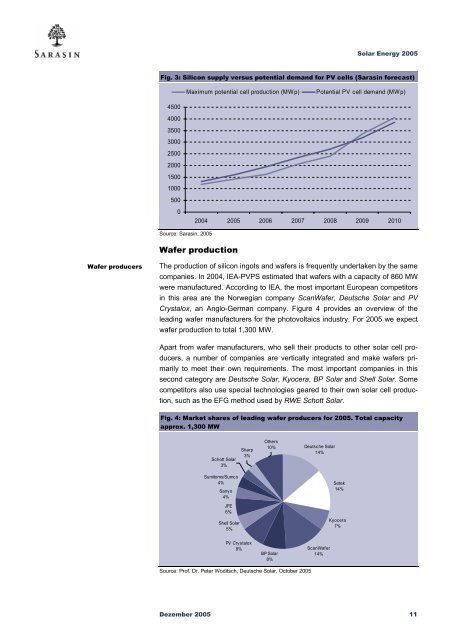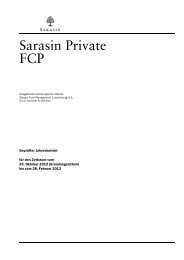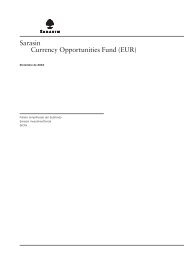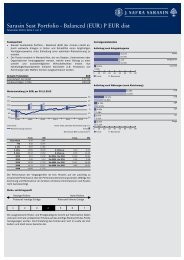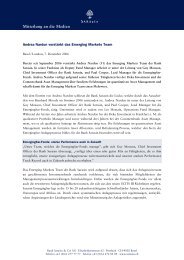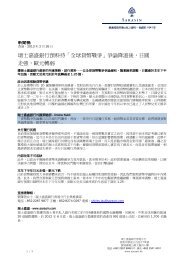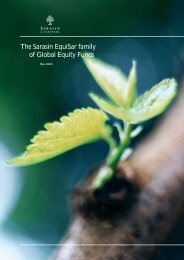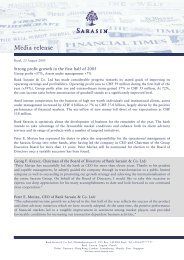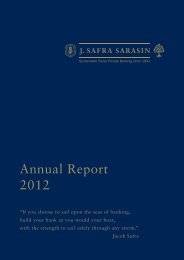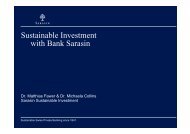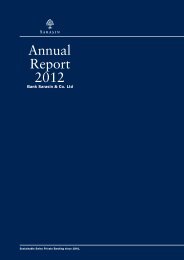Sustainability Report - Bank Sarasin-Alpen
Sustainability Report - Bank Sarasin-Alpen
Sustainability Report - Bank Sarasin-Alpen
You also want an ePaper? Increase the reach of your titles
YUMPU automatically turns print PDFs into web optimized ePapers that Google loves.
Solar Energy 2005<br />
Fig. 3: Silicon supply versus potential demand for PV cells (<strong>Sarasin</strong> forecast)<br />
Maximum potential cell production (MWp)<br />
Potential PV cell demand (MWp)<br />
4500<br />
4000<br />
3500<br />
3000<br />
2500<br />
2000<br />
1500<br />
1000<br />
500<br />
0<br />
2004 2005 2006 2007 2008 2009 2010<br />
Source: <strong>Sarasin</strong>, 2005<br />
Wafer production<br />
Wafer producers<br />
The production of silicon ingots and wafers is frequently undertaken by the same<br />
companies. In 2004, IEA-PVPS estimated that wafers with a capacity of 860 MW<br />
were manufactured. According to IEA, the most important European competitors<br />
in this area are the Norwegian company ScanWafer, Deutsche Solar and PV<br />
Crystalox, an Anglo-German company. Figure 4 provides an overview of the<br />
leading wafer manufacturers for the photovoltaics industry. For 2005 we expect<br />
wafer production to total 1,300 MW.<br />
Apart from wafer manufacturers, who sell their products to other solar cell producers,<br />
a number of companies are vertically integrated and make wafers primarily<br />
to meet their own requirements. The most important companies in this<br />
second category are Deutsche Solar, Kyocera, BP Solar and Shell Solar. Some<br />
competitors also use special technologies geared to their own solar cell production,<br />
such as the EFG method used by RWE Schott Solar.<br />
Fig. 4: Market shares of leading wafer producers for 2005. Total capacity<br />
approx. 1,300 MW<br />
Schott Solar<br />
3%<br />
Sharp<br />
3%<br />
Others<br />
10%<br />
Deutsche Solar<br />
14%<br />
Sumitomo/Sumco<br />
4%<br />
Sanyo<br />
4%<br />
Setek<br />
14%<br />
JFE<br />
6%<br />
Shell Solar<br />
5%<br />
Kyocera<br />
7%<br />
PV Crystalox<br />
8%<br />
BP Solar<br />
8%<br />
ScanWafer<br />
14%<br />
Source: Prof. Dr. Peter Woditsch, Deutsche Solar, October 2005<br />
Dezember 2005 11


